Designing a beautiful and sustainable home means prioritizing energy efficiency and eco-friendly materials. Start by choosing sustainable options like bamboo or reclaimed wood for your structure. Incorporate energy-efficient windows and proper insulation to keep your space comfortable year-round. Utilize solar panels for clean energy and invest in low-flow fixtures to conserve water. Location matters, too; select a site that minimizes environmental impact and offers easy access to public transport. With thoughtful planning, you can create a stunning home that’s good for the planet. Discover more ways to enhance your sustainable living experience along the way. When it comes to sustainable home design, don’t forget about the interior! Consider using eco-friendly paints and finishes, as well as repurposed or recycled furniture and decor. Sustainable interior design can greatly reduce your home’s environmental footprint while creating a beautiful and unique space. Incorporating these elements into your home will not only benefit the planet, but also contribute to a healthier and more mindful lifestyle for you and your family.
Key Takeaways
- Use high R-value insulation and energy-efficient windows to enhance comfort while minimizing energy consumption and costs.
- Incorporate renewable energy sources like solar panels and geothermal systems to achieve net-zero energy consumption and reduce reliance on fossil fuels.
- Select sustainable materials, such as bamboo and reclaimed wood, to lower your home's carbon footprint and improve indoor air quality.
- Implement water conservation strategies, including low-flow fixtures and rainwater harvesting, to significantly reduce water usage and enhance sustainability.
- Design compact, multi-functional spaces to maximize utility and comfort without expanding the home's footprint, promoting both beauty and efficiency.
Sustainable Home Design Principles
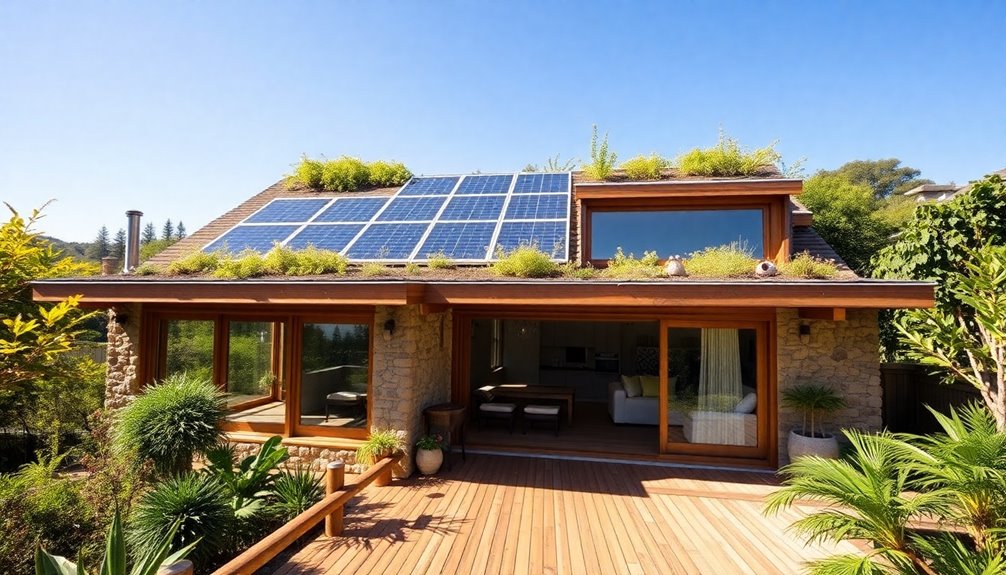
Sustainable home design principles focus on creating spaces that aren't only efficient but also environmentally responsible. By prioritizing energy efficiency, you can use high R-value insulation and energy-efficient windows to minimize your energy consumption for heating and cooling. Incorporating wood-burning stoves can significantly enhance heating efficiency while offering an eco-friendly alternative to traditional heating methods. Additionally, utilizing energy-efficient heat pumps can further reduce energy bills and improve indoor climate control. Regular maintenance of these systems is important to ensure their efficiency, as outlined in wood stove safety standards.
Incorporating renewable energy sources like solar panels and geothermal systems is essential for reducing your reliance on fossil fuels, ultimately helping you achieve net-zero energy consumption.
Water conservation strategies are also important in sustainable home design. Implementing low-flow fixtures and rainwater harvesting systems can greatly cut down your overall water usage.
Additionally, using locally sourced and recycled materials not only reduces transportation emissions but also supports local economies while promoting durability and low maintenance in construction.
To maximize comfort in your home, consider the thoughtful orientation of your design. This can enhance natural light and ventilation, reducing the need for artificial lighting and mechanical cooling. Furthermore, integrating heat pumps into your design can significantly improve your home's energy efficiency and indoor air quality. Regular inspection of your heating systems can prevent potential hazards and ensure safe operation.
Location and Site Selection
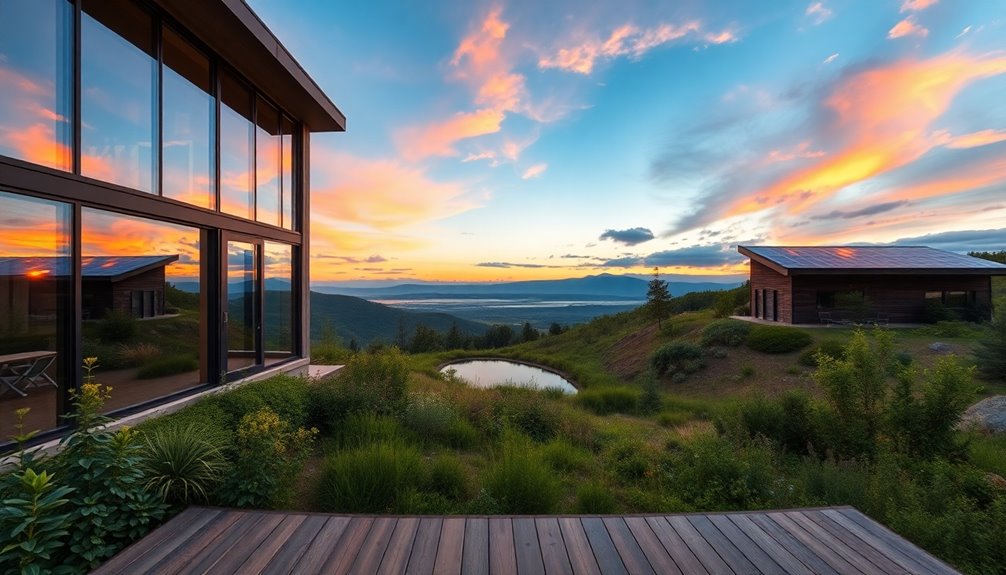
When you're choosing a site for your sustainable home, think about its accessibility to public transport; this can cut down on your carbon footprint considerably.
You'll also want to assess existing infrastructure and guarantee compliance with local zoning regulations, which can open up options for eco-friendly features. Additionally, selecting a location with energy-efficient models can significantly enhance your home's overall sustainability and comfort.
Public Transport Accessibility
Public transport accessibility is often a critical factor in site selection for new homes. By choosing a location that prioritizes public transport, you can greatly reduce your household's carbon footprint and energy consumption. Here are some key benefits:
- Lower reliance on personal vehicles
- Enhanced property values due to desirable accessibility
- Improved air quality from reduced traffic congestion
- Significant savings on commuting costs—up to $10,000 annually
- Greater community resources and amenities
Living near public transport not only promotes sustainable homes but also fosters a healthier lifestyle. With easier access to public transit, you'll find it more convenient to commute, run errands, and connect with your community.
Plus, integrating public transport in your site selection can lead to a vibrant neighborhood, making it easier for you to engage socially and enjoy local amenities.
Additionally, local zoning regulations often encourage developments around public transport hubs, making these areas even more appealing.
When you prioritize accessibility, you're not just investing in a home; you're investing in a sustainable future that benefits both you and the environment.
Environmental Impact Assessment
Evaluating the environmental impact of a location is essential for creating a home that aligns with eco-friendly principles. When selecting a site for your sustainable building, prioritize locations with access to public transport. This choice markedly reduces the carbon footprint associated with commuting and promotes an eco-friendly home lifestyle.
Assess the existing infrastructure, including utilities and roads, to minimize the environmental impact during construction. By choosing areas with established systems, you'll avoid disrupting natural ecosystems. Additionally, consider the availability of renewable wood fuel to support sustainable heating options in your new home.
Additionally, steer clear of sensitive zones like floodplains or habitats for endangered species; this not only protects the environment but also safeguards your investment.
Researching community resources and amenities is equally important. Proximity to schools, parks, and grocery stores enhances livability while encouraging sustainable transportation options.
As you plan, consider how the location can help you reduce energy and optimize materials and resources. Implementing waterproofing treatments can also be beneficial for any outdoor structures on your property, ensuring longevity and sustainability.
Zoning Regulation Compliance
Choosing the right location for your sustainable home goes beyond environmental impact; understanding zoning regulations is key to guaranteeing your design aligns with local standards. By complying with these regulations, you'll not only avoid penalties but also enhance the sustainability of your project.
- Zoning regulations dictate land use, building height, and density.
- Many municipalities encourage sustainable practices through specific codes, including green building certifications that may be required in certain areas.
- Green building certifications may be required in certain areas.
- Proximity to public transport can greatly lower your carbon footprint.
- Researching zoning laws can streamline your project timeline.
Before you plunge into design and construction, familiarize yourself with local zoning laws. This knowledge allows you to pinpoint suitable locations for your sustainable home, potentially near public transport options, which reduces your overall carbon footprint. Additionally, understanding these regulations can prevent costly modifications and delays during the building process, keeping your project timeline on track. Remember, sustainable practices aren't just about materials and design; they also encompass compliance with local standards, like renewable energy installations. Furthermore, integrating sustainable practices such as using EPA-certified wood stoves can significantly reduce emissions and improve air quality.
Moreover, exploring options for heat pumps can further enhance the energy efficiency of your sustainable home, providing both heating and cooling capabilities while reducing overall energy consumption. These systems can achieve efficiencies of 300-600% compared to traditional heating methods, making them a smart choice for sustainability.
Make zoning regulations a priority in your planning to guarantee your sustainable home thrives within its community.
Efficient Home Size and Layout
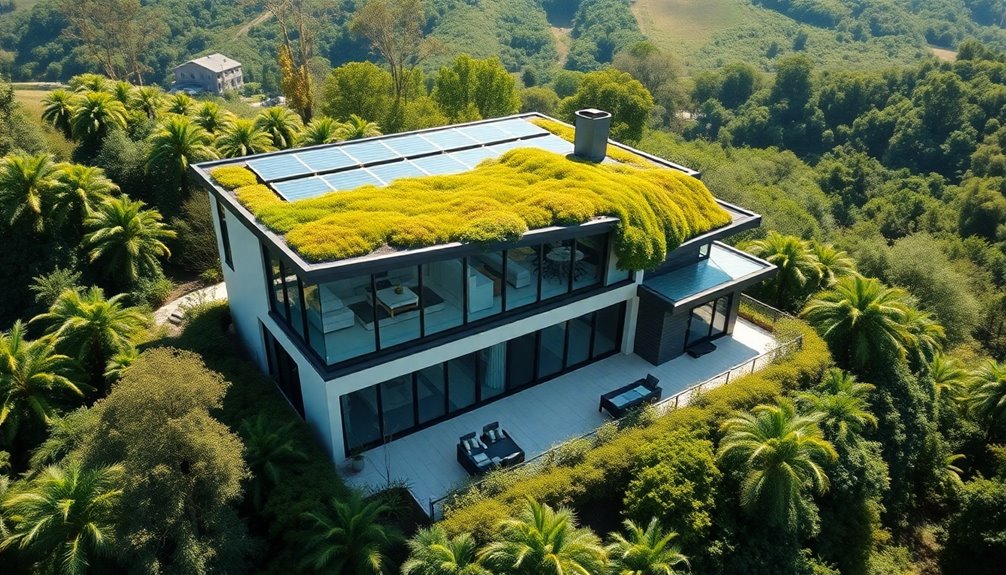
When it comes to designing a sustainable home, size and layout play essential roles in maximizing efficiency. Opting for an efficient home size, typically around 1,000 to 1,500 square feet, means you'll use fewer materials for construction, which helps reduce waste and lessen your environmental impact. Incorporating natural materials like wood and stone can further enhance the sustainability of your design. Additionally, utilizing weather-resistant materials can ensure longevity and reduce the need for frequent replacements. A well-organized space can also support mental clarity by minimizing distractions and creating a more serene environment.
Compact designs not only minimize heat loss but also greatly enhance energy efficiency; as your home footprint shrinks, so does energy consumption.
Consider a two-story layout; it can be more efficient than a single-story design by utilizing a smaller land area while still offering ample living space. Incorporating multi-functional spaces, like combining a home office with a guest room, allows you to maximize utility without expanding your footprint.
Additionally, a well-planned layout that prioritizes natural light and airflow can decrease your reliance on artificial lighting and HVAC systems. This thoughtful design approach not only boosts energy efficiency but also creates a more comfortable living environment. Adding vintage or distressed furniture can also enhance the overall aesthetic while promoting sustainability through upcycling.
Natural Light and Orientation
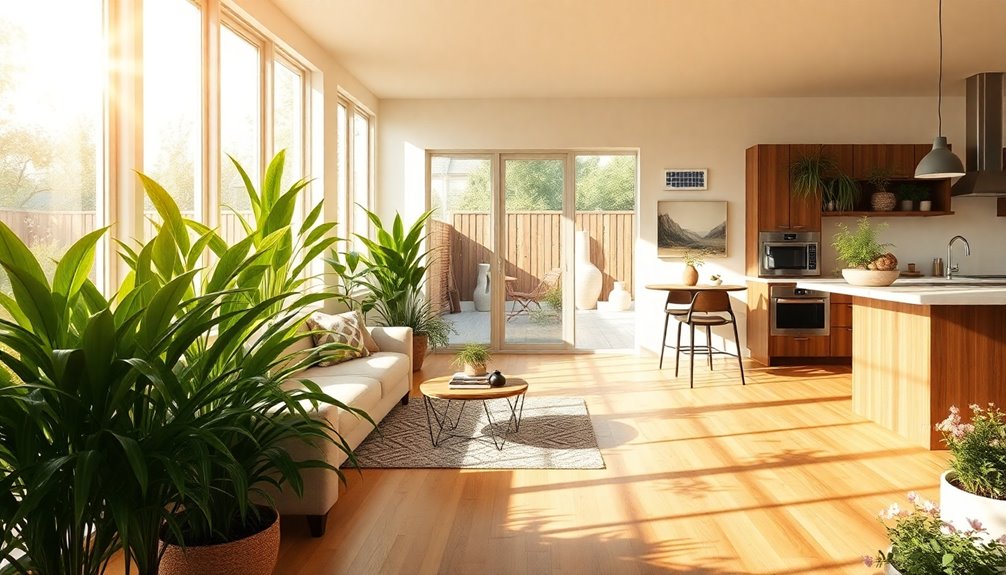
To enhance the sustainability of your home, paying attention to natural light and orientation is essential. By strategically positioning your windows and doors, you can maximize the benefits of passive solar design for energy efficiency and indoor comfort.
- Maximize south-facing windows for peak winter sun exposure.
- Minimize west-facing windows to reduce summer heat gain.
- Incorporate deciduous trees for natural shading and seasonal warmth.
- Use roof overhangs to control sunlight and minimize glare.
- Implement thermal mass and natural ventilation to stabilize indoor temperatures.
By aligning your home to make the most of natural light, you'll not only enhance your living space but also cut down on energy costs. South-facing windows allow sunlight to warm your home during colder months, reducing reliance on heating systems.
In contrast, minimizing west-facing windows helps keep your space cooler in summer, improving indoor comfort.
Additionally, integrating elements like roof overhangs and strategically placed trees can provide crucial shading while still allowing light in when needed.
Embracing these principles not only promotes a beautiful design but also guarantees a sustainable living environment.
Sustainable Material Choices

Sustainable material choices play an essential role in creating an eco-friendly home. By selecting sustainable materials like bamboo and reclaimed wood, you markedly reduce your environmental impact. These options have a lower carbon footprint and are more resource-efficient than traditional materials. Additionally, using oak wood for furniture and fixtures can provide both durability and sustainability, making it an exceptional choice for eco-conscious designs. Moreover, opting for energy-efficient designs can further enhance the sustainability of your home.
Plus, when you opt for locally sourced materials, you minimize transportation emissions and support your regional economy.
Durability is another key factor in your material selection. Choose materials with high durability and low maintenance requirements, such as recycled steel and low-VOC options. These choices enhance longevity and help reduce waste over time.
Additionally, incorporating materials with high thermal mass, like concrete and stone, will stabilize indoor temperatures, which can lower your heating and cooling costs.
Lastly, invest in sustainable materials that prioritize eco-friendly certifications, such as Forest Stewardship Council (FSC) certified wood. This guarantees responsible sourcing and contributes to biodiversity conservation. Furthermore, using natural materials like stone and bamboo can enhance the overall aesthetic and sustainability of your design.
Energy Efficiency Strategies
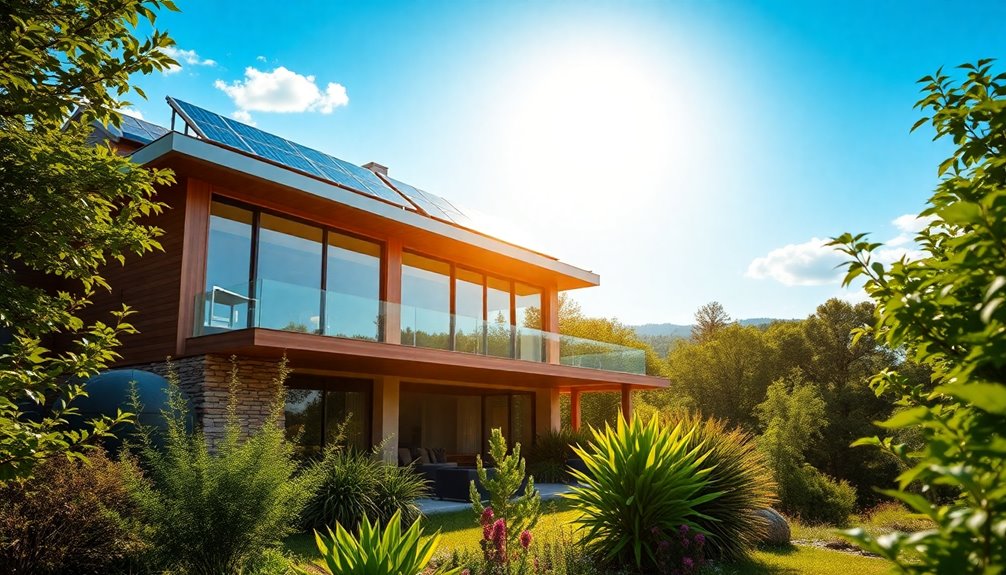
Selecting sustainable materials sets a strong foundation for your eco-friendly home, but energy efficiency strategies take your commitment to the next level.
By implementing these strategies, you can considerably reduce your energy consumption and create a more comfortable living environment.
- Use energy-efficient windows with low U-values or triple-glazed options to minimize heat loss and gain.
- Implement proper insulation techniques that exceed local energy codes for ideal temperature control. Regular maintenance of your heat pump can significantly enhance its efficiency over time, as energy efficiency ratings of systems like these is crucial for sustainability.
- Incorporate renewable energy systems like solar panels to offset operational energy costs and achieve net-zero energy goals.
- Utilize programmable thermostats and zone your HVAC systems for tailored heating and cooling, enhancing energy usage.
- Employ energy recovery ventilation (ERV) systems to maintain indoor air quality while minimizing HVAC energy consumption.
- Consider installing geothermal heat pumps to achieve significant energy savings and reduce your carbon footprint while enhancing overall comfort in your home. Additionally, leveraging renewable sources for hydrogen production can further promote sustainable energy practices.
Water Conservation Techniques
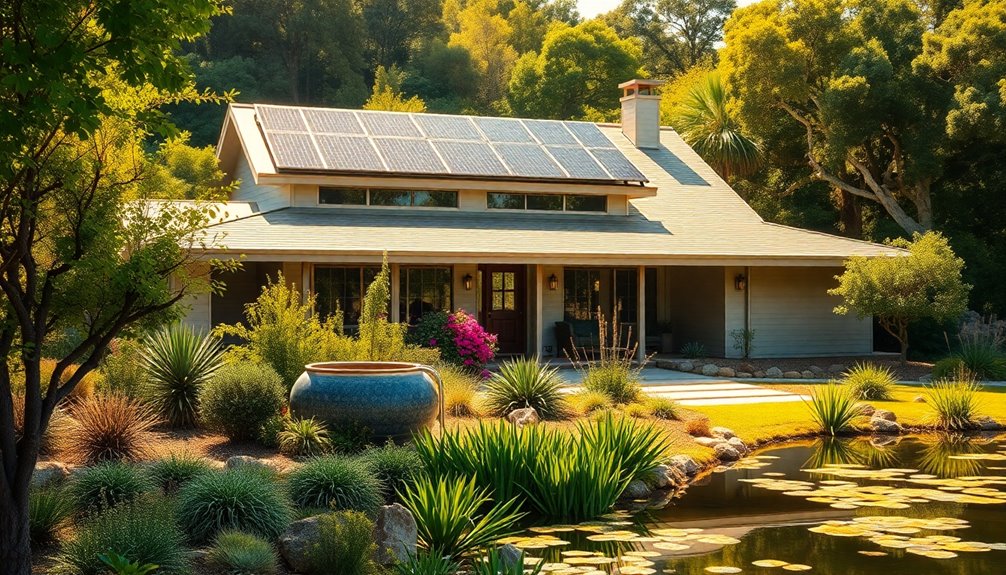
Water conservation techniques are essential for creating an eco-friendly home while also reducing utility bills. You can start by installing ultra low-flow fixtures, which can save you hundreds of gallons of water each year, markedly cutting down on household consumption.
Implementing a rainwater capture system allows you to collect and store rainwater for irrigation and non-potable uses, promoting sustainable water practices effortlessly.
Consider integrating greywater systems that recycle water from sinks, showers, and washing machines for irrigation. This further enhances your water conservation efforts and reduces overall dependence on municipal water supplies.
Drought-resistant landscaping is another smart choice; by utilizing native plants, you can minimize your irrigation needs, making your outdoor space both beautiful and sustainable.
Lastly, think about using permeable paving materials for driveways and walkways. These materials help manage stormwater runoff, allowing water to infiltrate the ground, which promotes groundwater recharge and reduces the risk of flooding.
Benefits of Sustainable Living

When you choose sustainable living, you'll notice an improvement in your indoor air quality thanks to non-toxic materials and better ventilation.
Plus, designing your home with energy efficiency in mind can lead to significant cost savings on utility bills over time.
Embracing these benefits not only enhances your well-being but also makes your home more economical. Additionally, the use of eco-friendly materials in construction can further reduce your environmental impact and contribute to a healthier living space.
Enhanced Indoor Air Quality
Enhanced indoor air quality is one of the standout benefits of sustainable living, and it can have a profound impact on your health. By prioritizing non-toxic materials and effective ventilation systems, you create a healthier living environment that reduces indoor air pollutants.
Here are some key advantages of enhancing your home's air quality:
- Improved respiratory health
- Reduced allergens and mold growth
- Enhanced overall comfort
- Lower risk of headaches and fatigue
- Increased energy levels
Using low-VOC paints, finishes, and flooring materials is essential in maintaining a clean atmosphere. These products emit fewer harmful substances, making your indoor air safer for you and your family.
Additionally, incorporating proper ventilation systems, like Energy Recovery Ventilation (ERV), guarantees fresh air circulation while minimizing energy loss.
Don't forget regular maintenance of your HVAC systems and air filters, as this can prevent dust and allergens from circulating throughout your home. Regularly checking and cleaning filters for air purifiers ensures optimal performance and helps maintain a healthy indoor environment.
Cost Savings Over Time
Improving your indoor air quality not only benefits your health but also sets the stage for considerable cost savings over time. By investing in a sustainable home, you can achieve energy-efficient designs that reduce energy bills by up to 30%. This means more money in your pocket each month.
Using Energy Star-rated appliances can further help, as they consume 10-50% less energy compared to standard models, leading to lower electricity expenses over time. Additionally, utilizing solar energy solutions can provide significant savings on your energy bills.
Additionally, implementing low-flow fixtures and rainwater harvesting systems can save hundreds of gallons of water annually, cutting your water bills significantly. Quality insulation and air sealing can yield a remarkable return on investment, often exceeding 100% by minimizing heating and cooling costs.
Don't forget that many governments offer tax incentives and rebates for sustainable home improvements, providing you with financial relief while offsetting initial costs. Furthermore, incorporating air purifiers with HEPA filters into your sustainable living strategy can enhance your home's air quality, ultimately supporting better health and well-being.
Frequently Asked Questions
What Is the Best Shape for a Sustainable House?
You might think any house shape works, but the best shape for sustainability is typically compact and geometric, like a square or rectangle.
This design minimizes surface area, cutting down heat loss in colder months. If you go for a two-story structure, you'll use vertical space efficiently, reducing material use and energy consumption.
Plus, consider the orientation; an east-west axis maximizes natural light and passive heating, further enhancing your home's efficiency.
How Can I Design an Eco-Friendly Home?
To design an eco-friendly home, start by prioritizing energy efficiency. Maximize natural light with south-facing windows and choose Energy Star-rated appliances to reduce energy use.
Incorporate sustainable materials like reclaimed wood or bamboo for both style and environmental benefits. Don't forget water conservation; install low-flow fixtures and consider a rainwater harvesting system.
Finally, select durable materials that last, minimizing the need for frequent repairs and replacements. Your thoughtful choices make a difference!
What 7 Elements Are Required for Sustainable Building Design?
Imagine your home as a superhero, fighting off high energy bills and water waste.
For sustainable building design, you need seven key elements:
- energy efficiency through insulation and windows;
- renewable energy sources like solar panels;
- water conservation strategies with low-flow fixtures;
- sustainable material selection;
- site orientation for natural light;
- effective waste management;
- and good indoor air quality.
Together, these elements work to create a resilient, eco-friendly living space you'll love.
How Do I Make My Home More Sustainable?
To make your home more sustainable, start by incorporating energy-efficient appliances and renewable energy sources like solar panels.
Implement water conservation strategies with low-flow fixtures and consider rainwater harvesting.
Prioritize native plants in your landscaping to reduce water use.
Invest in high-quality insulation and air sealing to minimize energy loss.
These steps not only lower your utility bills but also contribute positively to the environment, creating a healthier space for you and your family.









